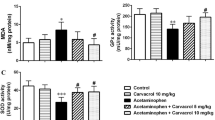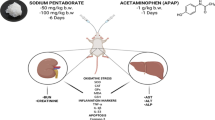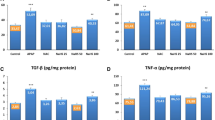Abstract
Acetaminophen (APAP) is one of the popular and safe pain medications worldwide. However, due its wide availability, it is frequently implicated in intentional or unintentional overdoses where it can cause severe liver injury and even acute liver failure. Boron is a bioactive trace element, found naturally as boric acid (BA) and borate. In this study, the effects of boric acid on the acute renal toxicity induced by APAP in rats were researched in comparison with N-acetyl cysteine (NAC). In the study, 7 groups were formed and 2 g/kg dose of paracetamol per rat was prepared by suspending in 1% Carboxy Methyl Cellulose (CMC) solution of phosphate buffer saline (PBS). Boric acid dissolved in saline was administered to experimental animals by gavage at doses of 50, 100, and 200 mg/kg. In this study, ER stress and apoptosis formed by paracetamol-induced nephrotoxicity were investigated. This purpose determined iNOS, PERK, ATF6, NFkB p53, caspases 3, 12, bcl-2, and bcl-xL gene mRNA expression kidney tissue. Also, the levels of kidney injury molecule-1 (KIM-1), Cysteine (Cys), and IL-18 levels, which are mentioned today as kidney damage markers were compared with BUN and creatine levels. The effect of boron on kidney damage was determined by histopathologic. Data were statistically analyzed by using SPSS-20 ANOVA and stated as means and standard deviation. According to the data obtained in our study, we believe that boric acid has a protective effect on the negative effects of paracetamol on the kidney. We believe that our study will provide useful data to the literature on the possibility of a supplement to be used as an active compound in paracetamol for the prophylaxis of boric acid and it can also be converted into a useful product.

Similar content being viewed by others
References
Lewis RK, Paloucek FP (1991) Assessment and treatment of acetaminophen. Clin pharm 10:765–774
Spooner JB, Harvey JG (1976) The history and usage of paracetamol. J Int Med Res 4(4_suppl):1–6
Bessems JG, Vermeulen NP (2001) Paracetamol (acetaminophen)-induced toxicity: molecular and biochemical mechanisms, analogues and protective approaches. Crit Rev Toxicol 31(1):55–138
Corcoran GB, Mitchell JR, Vaishnav YN, Horning EC (1980) Evidence that acetaminophen and N-hydroxyacetaminophen form a common arylating intermediate, N-acetyl-p-benzoquinoneimine. Mol Pharmacol 18(3):536–542
Randers E, Erlandsen EJ. Serum cystatin C as an endogenous marker of the renal function–a review. Review Clin Chem Lab Med 37(4):389–395
Gharishvandi F, Kazerouni F, Ghanei E, Rahimipour A, Nasiri M (2015) Comparative assessment of neutrophil gelatinase-associated lipocalin (NGAL) and cystatin C as early biomarkers for early detection of renal failure in patients with hypertension. Iran Biomed J 19(2):76
Petzold K, Poster D, Krauer F, Spanaus K, Andreisek G, Nguyen-Kim TD, Pavik I, Ho TA, Serra AL, Rotar L (2015) Urinary biomarkers at early ADPKD disease stage. PLoS One 10(4):e0123555
Acaroz U, Ince S, Arslan-Acaroz D, Gurler Z, Kucukkurt I, Demirel HH, Arslan HO, Varol N, Zhu K (2018) The ameliorative effects of boron against acrylamide-induced oxidative stress, inflammatory response, and metabolic changes in rats. Food Chem Toxicol 118:745–752
Coban FK, Ince S, Kucukkurt I, Demirel HH, Hazman O (2015) Boron attenuates malathion-induced oxidative stress and acetylcholinesterase inhibition in rats. Drug Chem Toxicol 38(4):391–399
James P, Jamshed S, Elkalmi R, AlShami A, Nor A, Kabir F, Sumali I, Zubair A, Shamsudin S (2018) Causes of stress and management approaches among undergraduate pharmacy students: findings from a Malaysian public university. Arch Pharmacy Pract. https://archivepp.com/storage/models/article/OWKxUy7ThmiKWrTfhRjXxD1c1e0J4k0W50xF8hvImW0atkhb5bHGRkL6mwfu/causesof-stress-and-management-approaches-among-undergraduate-pharmacy-students-findings-from-a-m.pdf
Zehra F, Naqvi AA (2017) The Global Halal Pharmaceutical Market: strengths, challenges, and prospects. Arch Pharm Pract 8(3):85–87
Palaian S, Mohamed Ibrahim MI, Mishra P (2016) Development of pharmacovigilance training module for community pharmacists in Nepal: a focus group study. Arch Pharmacy Pract 7(4)
Wei CT, Omar MS (2016) Current practice and determinants of medication management in long term care facilities. Arch Pharmacy Pract 7(3):73–79
Trumper L, Girardi G, Elías MM (1992) Acetaminophen nephrotoxicity in male Wistar rats. Arch Toxicol 66(2):107–111
Hu JJ, Lee MJ, Vapiwala M, Reuhl K, Thomas PE, Yang CS (1993) Sex-related differences in mouse renal metabolism and toxicity of acetaminophen. Toxicol Appl Pharmacol 122(1):16–26
Mazer M, Perrone J (2008) Acetaminophen-induced nephrotoxicity: pathophysiology, clinical manifestations, and management. J Med Toxicol 4(1):2–6
Naguib YM, Azmy RM, Samaka RM, Salem MF (2014) Pleurotus ostreatus opposes mitochondrial dysfunction and oxidative stress in acetaminophen-induced hepato-renal injury. BMC Complement Altern Med 14(1):1–2
Das J, Ghosh J, Manna P, Sil PC (2010) Taurine protects acetaminophen-induced oxidative damage in mice kidney through APAP urinary excretion and CYP2E1 inactivation. Toxicology 269(1):24–34
Colak S, Geyikoğlu F, Keles ON, Türkez H, Topal A, Unal B (2011) The neuroprotective role of boric acid on aluminum chloride-induced neurotoxicity. Toxicol Ind Health 27(8):700–710
Ince S, Kucukkurt I, Cigerci IH, Fidan AF, Eryavuz A (2010) The effects of dietary boric acid and borax supplementation on lipid peroxidation, antioxidant activity, and DNA damage in rats. J Trace Elem Med Biol 24(3):161–164
Kucukkurt I, Akbel E, Karabag F, Ince S (2015) The effects of dietary boron compounds in supplemented diet on hormonal activity and some biochemical parameters in rats. Toxicol Ind Health 31(3):255–260
Samman S, Naghıı MR, Lyons Wall PM, Verus AP (1998) Determining the accumulation level of some elements, especially Baron in the plants growing in close districts of Seydisuyu (Eskişehir). Biol Trace Elem Res 66(1–3):227–235
Mazaleuskaya LL, Sangkuhl K, Thorn CF, FitzGerald GA, Altman RB, Klein TE (2015) PharmGKB summary: pathways of acetaminophen metabolism at the therapeutic versus toxic doses. Pharmacogenet Genomics 25(8):416
Ince S, Turkmen R, Yavuz H (2011) The effect of boric acid on acethylcholine, bethanechol and potasssium-evoked responses on ileum of rat. Auton Autacoid Pharmacol 31(3–4):50–56
Funding
This study was supported by the Usak University Scientific Research Project Coordination Unit (2017 /MF008), and TUBITAK with the project number of 216S671.
Author information
Authors and Affiliations
Contributions
H.A. was responsible for overall supervision. F.K.Ç., S.İ, H.H.D., İ.İ, and H.A. contributed to all experimental work, data and statistical analysis, and interpretation of data. H.H.D. drafted the manuscript, which was revised. All authors read and approved the final manuscript.
Corresponding author
Ethics declarations
Competing Interests
The authors declare no competing interests.
Additional information
Publisher’s Note
Springer Nature remains neutral with regard to jurisdictional claims in published maps and institutional affiliations.
Rights and permissions
About this article
Cite this article
Çoban, F.K., İnce, S., Demirel, H.H. et al. Acetaminophen-Induced Nephrotoxicity: Suppression of Apoptosis and Endoplasmic Reticulum Stress Using Boric Acid. Biol Trace Elem Res 201, 242–249 (2023). https://doi.org/10.1007/s12011-022-03114-9
Received:
Accepted:
Published:
Issue Date:
DOI: https://doi.org/10.1007/s12011-022-03114-9




